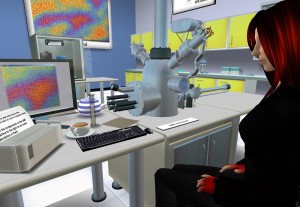Virtual worlds
After the Hype Machine
Do you remember virtual worlds? They haven’t gone anywhere, but back in the middle of the last decade, 2006-2009, they were getting a good deal more attention than they are now. Names from the automotive industry, news agencies, music labels, and even universities jumped in to see what all of the hype was about. Worlds such as Second Life, Open Sim, Kaneva, and Blue Mars were just some of the virtual spaces people could walk into. Institutions of higher learning flocked in to see what all the excitement was about.
Second Life is a world that had a large number of participants and momentum behind it a few years ago. It was founded on the idea that users would create the content. Residents create their own clothing, hair, buildings, dance moves, vehicles, you name it. They can even sell their creative services to others on the in-world economy, which makes it possible for them to earn real world revenue. The world’s hot item, as far as academics is concerned, is the placticity of its environment. People can meet up with each other in real time, with a fully customizable visual representation of themselves. They can chat by text or voice about whatever interests them with others who are connecting from all over the world. They can take the form of anything in virtually any type of setting that they can imagine.

Being able to customize the visual environment to a particular context is a feature that makes it an intriguing space for universities to explore. Learning a language? You can meet up with your class at a virtual hotel outfitted with all of the amenities, then role play scenarios without having to travel to another country. You can walk into an examination room of a doctor’s office and practice the process of taking patients’ medical histories and vital readings. You can even explore the fictional construct of Hell imagined by Dante in his Inferno. From Ivy League schools to community colleges, instructors have found applications for this virtual world that range from literature to mathematics, biology, and even fashion design.

Dr. Julie Fronzuto, Assistant Professor of Biology at Prince William Sound Community College here in Alaska, has been using Second Life regularly with her students in a virtual wet lab, thanks to the assistance of designer Don Bickley.
Today, however, virtual worlds seem to be at the long tail of the hype cycle, with many of the worlds having disappeared from the virtual universe. Second Life is still around, with its own devoted following, but it has less participation than in past years. CTL had an island there but we decided to close it down this year. The decision was driven by a few considerations. When we originally began exploring, we were curious as to what was possible from a learner’s perspective. We wondered how easy it was to build customized meeting spaces and how much time was involved in building pieces that could be used in courses. We learned a great deal and talked to other educators trying new things themselves. The reality is that the amount of bandwidth required to connect to a world like Second Life makes the platform too demanding for the typical internet connection here in Alaska. That doesn’t seem like it will change in the near future.

The technological barriers for entry into worlds like Second Life are steep. The highly customizable, high-resolution virtual worlds of the past decade are sexy and exciting, but also a lot of work. There are still some educators there who have found it a space that affords them the ability to do things they wouldn’t otherwise be able to do in class, but the cost in time and money to operate there is too steep for the majority of them. As it is for us at the moment.
Download a printable version of this Virtual Worlds Teaching Tip (PDF)

